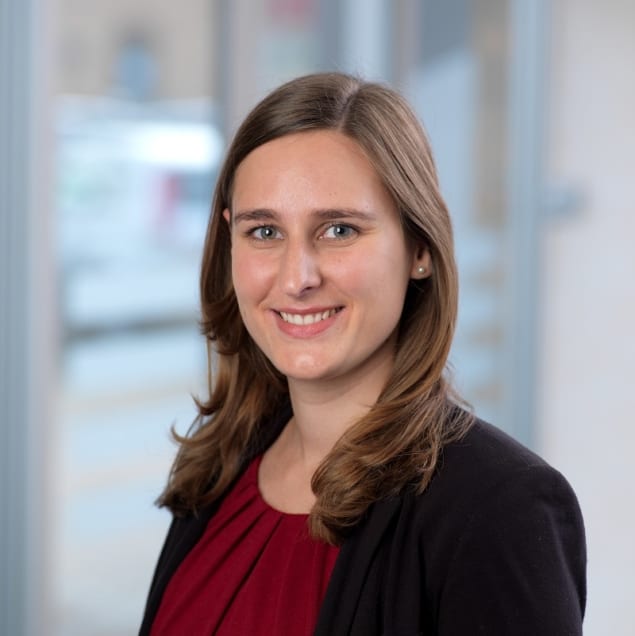TTP’s multidisciplinary team of scientists and engineers work with a diverse client base to invent, design and develop new products and technologies with lasting commercial impact

Like many postgraduate physicists, Hannah Hare was confronted with the classic stick-or-twist dilemma upon completion of her PhD studies at the University of Oxford, UK. Stick would have meant following the traditional academic path – most likely building on and developing her graduate research on the use of noninvasive functional MRI techniques to enhance diagnosis and treatment of stroke patients. She decided to twist, as it turns out, and headed in an altogether different direction after securing a role as a scientific consultant at TTP, an independent technology company where a multidisciplinary staff of 230+ scientists and engineers delivers breakthrough product innovations for clients across a range of industries – from telecoms and computing to healthcare and advanced manufacturing.
What attracted Hare to TTP is a working model that starts and ends with multidisciplinary collaboration. “I really got the sense that I’d continue to learn and do all sorts of new science here,” she explains. “After completing my PhD, I knew I didn’t want to end up as a hyper-specialist within a large R&D organization, making incremental improvements in a narrow field of research.”
Since making the transition to industry in 2015, Hare has grasped the opportunity to broaden her experience at the interface between science, engineering and business. Working as part of TTP’s Sensors and Devices group, she focuses largely on new biosensing technologies for healthcare applications – for example, blood glucose sensors, blood pressure monitors and neurostimulation devices. “The common thread here is you’re working on product innovations that are close to market,” Hare adds, “so TTP is a great place for someone who wants to stay in an R&D environment but also have an impact on the real world – whether that’s for our clients, their customers or patients [in the case of the biosensing programme].”
Focusing on impact
Operationally, TTP is structured around custom R&D projects for a diverse client base, ranging from technology start-ups to established blue-chip organizations. While customer-facing activity predominates, there are also many internal R&D projects under way at any one time, some of which will yield spin-out technologies and new commercial opportunities – for example, TTP’s LEX thermal control technology for DNA amplification in point-of-care diagnostics.

Given that backdrop, every day is different for TTP consultants, whether they’re working in the lab – performing experiments or running computer simulations to elucidate the underlying physics of a customer problem – or out in the field pitching the business to prospective clients. “As a new consultant,” notes Hare, “you’re part of the conversation with the client very early on.”
It’s a steep learning curve. As well as getting to grips with a broad spectrum of new science, there’s the effective communication of that science – with the emphasis on interpretation, analysis and recommendation over granular technical information. Is there a market for this technology? Can this new product deliver the desired price:performance at scale? What other technology options can achieve the desired outcomes?
“These are the sorts of questions that TTP consultants seek to answer,” says Hare. “It’s a big culture change for sure: the shift from writing academic papers – essentially for other experts in your field – to concise business reports and presentations that address the commercial questions and concerns our clients really care about.”
Translational science
That commercial mindset also frames and informs the multidisciplinary conversations that happen day in, day out at TTP. (In normal times, all of the firm’s consultants are co-located at TTP headquarters near Cambridge, UK, though most staff are currently working from home as a result of the Coronavirus restrictions.) “It’s a two-way street – you learn from your colleagues and they learn from you,” Hare says of the firm’s collaborative culture, while at the same time acknowledging that not all scientists and engineers speak the “same language”.
“I have found that biologists and engineers, for example, sometimes struggle to understand one another during the early phases of a project,” Hare explains. “They use different words for similar things, but more crucially their focus is very different.” Biologists need to keep “pesky little cells alive at all costs”, she notes, and the way that different molecules and cells interact with each other is often unpredictable, making the development of new diagnostics challenging and unpredictable. Engineers, by contrast, tend to lay out detailed plans and follow them linearly, as their work is more predictable and often highly regulated.
Physicists fall perfectly between these two extremes, making them ideally placed for “translation” between fundamental scientific research – whether internal to TTP or carried out by its clients – and the needs of high-volume, robust and reliable engineering. “This interface is where the biggest opportunities lie, bringing together different disciplines to create truly ground-breaking new products,” Hare adds. “It means we as physicists are able to learn from both ends of the spectrum, explain the needs of one discipline to another, and help make crucial decisions to balance conflicting requirements such as accuracy, cost, reliability, lifetime, development time and commercial risk.”
That upside extends to the many clients who approach TTP having already demonstrated a new lab technique but needing to scale up to a commercially viable product. “In these cases,” says Hare, “physicists are usually first on the scene, understanding from our clients how their technology works and where its limits lie, so that we can develop a set of requirements to pass on to the engineers.”
Personal growth = commercial growth
From an employee perspective, a unique and attractive aspect of TTP is its flat management structure, with most consultants having a direct stake in the business (the firm is privately owned by current and former employees). As such, the company prioritizes autonomy and self-directed personal development and career progression.
Consultants, for example, will often lead on one project while providing lab-based support on several others. Hare is a case in point. After just six months in post, she led a project to design a new blood-pressure monitor and has since progressed to more complex briefs with bigger teams and bigger budgets. Right now, she heads a project to develop a low-cost disposable device for peripheral nerve stimulation – a collaboration with Neurent Medical, a start-up based in Galway, Ireland. The aim is to come up with a clinically approved treatment for rhinitis (an allergic inflammation of the inside of the nose) by stimulating nasal nerves with a small amount of electricity.
You’re not micromanaged here. There’s a lot of freedom to pursue the career track that best fits your skill-set.
Hannah Hare, TTP
“You’re not micromanaged here,” says Hare. “There’s a lot of freedom to pursue the career track that best fits your skill-set. Day-to-day there’s also a lot of variety – a morning of lab work might be followed by a few hours drafting a client pitch or a brainstorming session with colleagues on a new project.”
Hare, for her part, has gravitated towards business development activities, on which she currently spends most of her time. She’s currently applying her background in neuroscience and medical imaging, alongside TTP’s engineering know-how, to develop commercial opportunities in neural interfaces – whether that’s smart brain implants to reduce the life-limiting symptoms of Parkinson’s disease or novel noninvasive techniques to help patients with neurological conditions such as Alzheimer’s, severe depression or epilepsy.
While the commercial objectives are clear, this is slow-build, client-facing work that requires direct engagement with established manufacturers and start-ups in the medical device sector – though it’s often the latter pushing truly game-changing innovations. “Putting together a full team for hardware development is a massive undertaking for any start-up,” says Hare, adding that this is where TTP comes into its own by providing a tailored science and engineering team to match their ambitions.
“Ultimately,” she concludes, “it’s the combination of skill sets – from fundamental science to large-scale engineering – that sets us apart, that allows us to create ground-breaking new technologies, and that makes TTP such an exciting place to work.”
• Find out more about TTP careers and current vacancies at Why TTP




